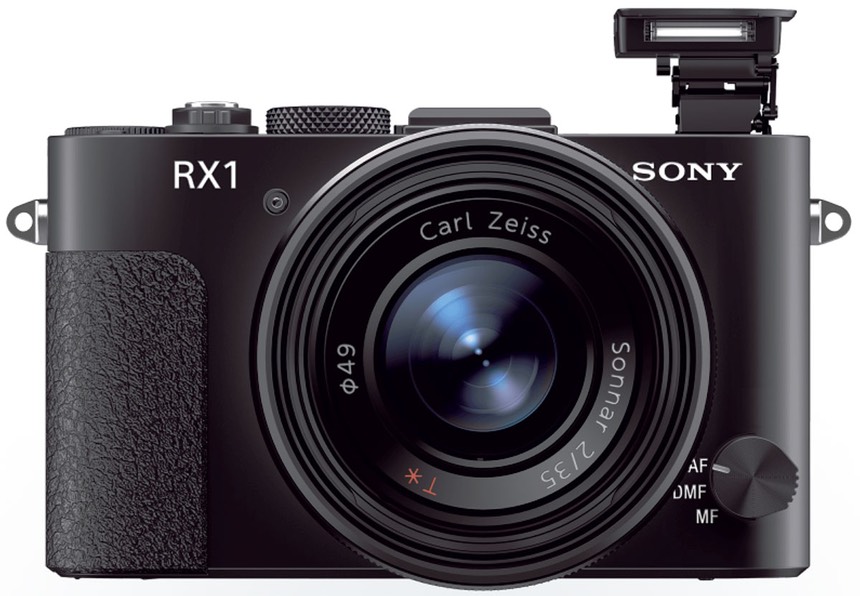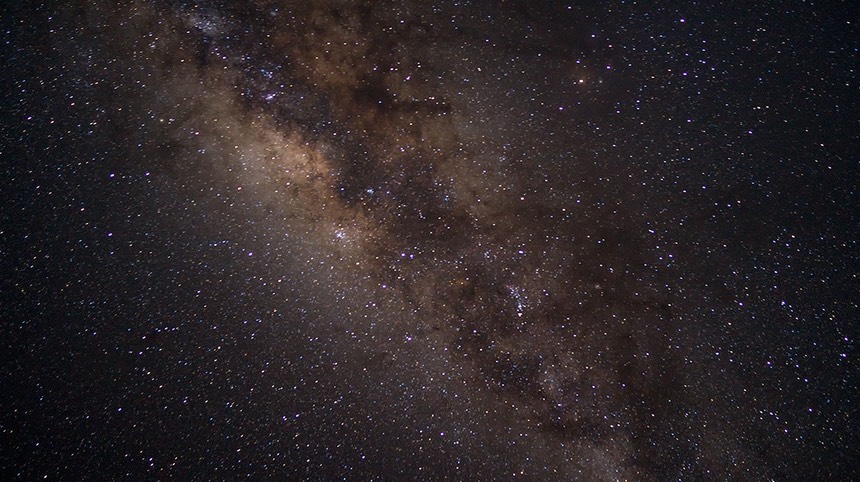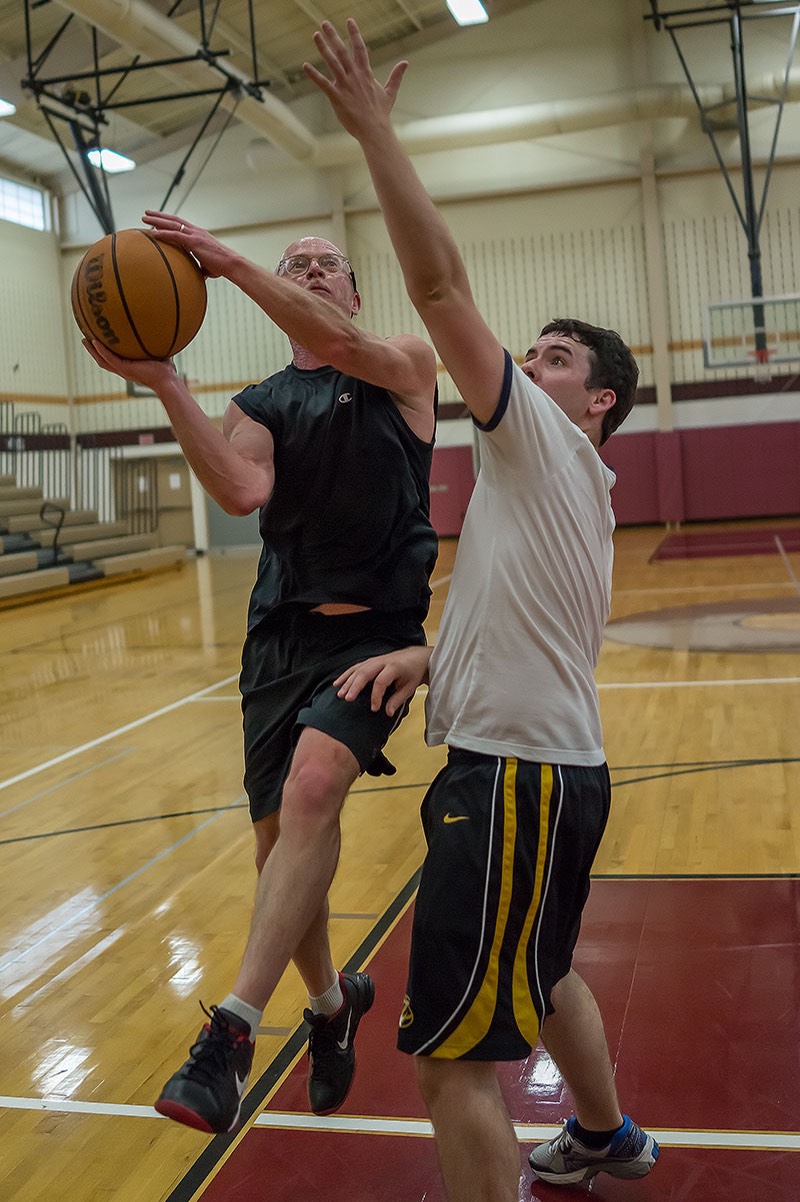
What is It?
Continuing with our exploration of the large-sensor Sony "compact" cameras we have the RX-1. Calling this "compact" is a bit of a misnomer, as it's not close to a shirt pocket camera. It's more the size of a small rangefinder camera. Even some mirrorless camera body and lens combinations are smaller than the RX1 (the RX1 is about the same size as a Sony NEX-6 with its kit lens collapsed). So "compact" here really means that the RX-1 is an all-in-one camera in smallish form: it features a built-in Zeiss-designed 35mm f/2 lens.
On the other hand, the RX1—and its twin, the RX1r, which I'll get to—uses a full frame sensor (~24x36mm, or the size of 35mm film). The RX1 is the most compact camera using such a sensor, though Sony itself has recently put that in question with the A7/A7r combo.
Let me point out the salient features:
- 24mp full frame sensor (similar to what's used in Nikon D610, Sony A7)
- Zeiss 35mm f/2 lens with aperture ring, a leaf shutter, and a modest macro facility
- Solid metal framed body
- A bit of retro with exposure compensation and Mode dials up top
- Five user-customizable buttons, one command dial, 3 custom recall settings on Mode dial
- A 1.23m dot LCD with what Sony calls WhiteMagic (good brightness outdoors)
- A small built in flash, flash sync to 1/2000, and a hot shoe with additional connections
- The ability to record up to 1080P/60 (50P in PAL regions)
- The ability to mount an optional EVF
A few other features are a sweep panorama mode, Scene modes, and the ubiquitous all Auto mode. Of those, only the panorama part is something I find useful.
Front lens filter ring is 49mm, and the front lens cap is pinch-type (which is good if you always use the optional lens hood).
The RX1 uses the same small battery as the RX100 (rated 270 shots CIPA on the RX1). Cost of the camera is a hefty US$2800. The difference between the slightly lower priced RX1 and the RX1r is that the r model doesn't have an anti-aliasing filter over the image sensor.

How's it Handle?
The design is very minimal and understated for the most part. Unless you put the optional EVF on the camera, it's close to the "bar of soap" design with minimal protruding controls. Fortunately, there's some leatherette grip on the front hand position and rear thumb position, so the camera doesn't tend to slide out of your hand easily.
But slide it will, because it also weighs in at a pretty hefty one pound (482g). That's a lot to hold with just a pincher grip on leatherette, and it gets difficult to do in moist, icy, or damp conditions, or with certain types of gloves on. It's a pity that Sony didn't build a bit of a hump into the front grip position; that would enhance the handling quite a bit. Sony does sell a far too expensive TGA-1 thumb grip for the camera (US$250), which helps, but I don't think that's the right solution. A less expensive and better solution is Really Right Stuff's BXR1-Set, which includes both an Arca-style L-plate but also a detachable front grip.
As I noted in my review of the RX100 models, Sony has found a new UI that's a bit DSLR-like and very straightforward. Indeed, moving from the menus and controls of the RX1 to the RX100 and back is like using to highly related cameras. If you do a menu dip, you'll find a logically organized system with understandable names that's easy enough to navigate. As a Nikon guy, I still have to get used to not pressing the right side of the Direction pad to enter a menu item (you have to press the center button on the Sonys), which slows me down a bit, but Sony themselves are consistent, so I can't complain. This is one of the joys of trying to move back and forth between maker's systems: you'll find these cognitive dissonances to slow you down; which is one reason why I recommend you to stick to one maker or another where possible.
The click-stopped aperture ring is a nice touch, and it runs in third-stop intervals from f/2 to f/22. The command dial at the top rear can work the shutter speeds for you, so those that like the retro type controls for the Big Three can work in Manual exposure mode and use three nice dials to set all but the ISO for exposure. The default is that the small button to the right of the shutter release on the top plate can be used to set ISO with a dial, so it isn't far away from retro.
Overall, controlling most things in shooting is straightforward and doesn't require menu dipping. Plus, again, you have the ability to assign things to five buttons (three of those are Direction Pad buttons, which would allow you to set the RX1 to the same thing as any other compact camera you might be using). All the controls are precision, have strong snap-to positions where necessary, and very nice feel to the rotations. Lens focus is fly-by-wire, but the ring is smooth and the motion is well controlled.
There are some things that aren't as lovable as they should be on the RX1. First up, the macro setting for the lens is right up front next to the focus ring. Despite the different feel, more than once I missed getting the right ring when I wanted to use it. That was especially true when I had the camera up to my face using the EVF.
Meanwhile, the LCD isn't tiltable. So if you aren't using the EVF, you're pretty much in the "compact salute" mode, where you hold the (heavy) camera only straight out from you.
The hot shoe has the electronic connections for the optional EVM1K EVF (US$450), and I actually like the camera/EVF combo a lot. The EVF can tilt up to 90° up, so this partially solves the fixed LCD problem, at least for low angle shooting. Amazingly, Sony charges more for a plain old optical viewfinder (V1K made by Zeiss for US$600)
Manual focus has some focus aids that are helpful, starting with a distance scale in the viewfinder (or LCD) and either a 5.9x or 11.7x magnification of the central area. You can adjust how long the camera stays in magnified view, and you can also have the camera show focus peaking (but only in magnified view). These things work okay on the rear LCD, better on the EVF (which has more resolution).
Sony has aligned the tripod socket and the hot shoe with the center of the lens, and there's plenty of room to get a decent plate on the camera without worrying about getting access to the battery compartment door.
How's it Perform?
Battery: The RX1's biggest weakness is that it sucks batteries. That's especially true if you're using the optional EVF. I don't think I ever got to 200 shots with the EVF, and I had to watch my power use a bit to manage to get to 300 with the LCD. Short answer: carry lots of extra batteries. They're small and light. But frankly, this was a bad battery choice by Sony, I think, especially considering the EVF option. This is a shame, because it takes the RX1 from being a use-all-day-always-ready camera to one that you have to keep an eye on the battery with. But here's a Big Shame factor Sony needs to fess up to: they don't provide a dedicated battery charger with the camera. Plugging the camera into a USB port charges the battery, but not exceptionally fast. Basically budget to buy a dedicated charger. Fortunately, third party models are carried by places like B&H and are not expensive.
Write speed: The RX1 isn't a speed demon type of camera. It's designed for the more deliberate shooter. You can get 5 fps, but with no display refresh. If you want everything to work as normal, your top speed is 2 fps with a reasonably deep buffer (minimum 30 frames JPEG or 14 frames raw+JPEG). A full write to the buffer can take over 10 seconds, but even if you fill the buffer the camera is only dropping down to no less than 1/4 the usual continuous drive speed (e.g. about half frame a second). Set JPEG/Fine on a fast card and you can shoot continuously at 2 fps for as long as you'd like. All in all, the makes the RX1 a strange mix: the deep buffer coupled with relatively low continuous shooting speed with everything operational means you rarely fill the buffer. Indeed, if you select JPEG Fine only you can pretty much shoot forever with the RX1. Okay, until you run out of card space, then.
Lens: in a word: Zeiss. Strong central sharpness, even wide open, with corners that don't slip down a lot. The center is probably sharpest at f/4, the edge at f/5.6, so f/4, f/5.6, and f/8 are probably the apertures you want to keep towards, especially if you get the RX1r model without the AA filter. As I'm seeing more and more often, the other parameters aren't as good as the sharpness. That's probably because everyone now thinks that you can just "fix" those things in software. Well, you can, but you lose a bit of resolution in doing so. There's no free lunch.
Vignetting in raw files is pretty high at f/2, nearing 2 stops at the corners, though the central area that doesn't vignette is reasonably large. By f/4 the lens is well behaved in vignetting, with only the extreme corners getting any noticeable drop.
Chromatic Aberration is pretty well controlled, and tends to be of the cyan/red type. I haven't really seen any examples where I feel like I have to correct it though. It's just not infringing upon enough pixels to be problematic.
The lens has very visible barrel distortion of around 2%, and it gets worse at close focus (e.g. macro). Unfortunately, this isn't straight barrel distortion. It's not quite mustache distortion, either. To my eye, it looks like stepped barrel distortion, where as you move further from the center you hit points where the "curve" gets stronger. If linear distortion bothers you, you'll want to make sure you have a software tool that is designed specifically for this lens.
Focus: And here's our first big issue. Focus is compact-camera like, and not suitable for moving subjects. Focus also struggles in low light with low contrast subjects. The good news is that this is a 35mm lens, so you could just Zone Focus and shoot. The manual focus controls come into play here, as does the DOF of a 35mm lens versus a more-normal 50mm lens. Yes, this camera can be used as a street shooter, but you'll need to take a little more control and rely less on the autofocus than with some other cameras would make you do.
Resolution and Dynamic Range: The 24mp Sony sensor is already well established. Even the previous versions used by Sony were quite good, but we've also seen how well the more current versions perform on D3x and D610 bodies to name a few. In short, very strong results. Lots of dynamic range, low noise propagation, strong resolution figures. What more can you want?
I should point out that Sony isn't giving you the raw values off the sensor. They cook in some vignetting correction, but they also use an interesting form of compression that can lose some data, too. Frankly, I haven't seen any files where I'm bothered by either, but just note that you're a little further from the actual raw data the sensor collected than you think.
One good test of a sensor is the Milky Way (ISO 3200, f/2.8, 30 seconds; which turns out to be a little too much exposure for this camera/lens):

As expected, a pretty solid result. But let's go a little deeper. Here's one my guides in Africa (Jono) sitting at the campfire at night. This shot is 26 seconds shutter speed at f/8, and yes, Jono does a great imitation of a statue when asked ;~). Note that tree over his right shoulder that has some of its lower branches partly lit by a camp lantern (and I can see what's going on in either distant tent on the edges of the shot, both of which were lit by a small LED lamp):

Let's just grab that section of the tree and pull it up several stops:

Yep, there's actually reasonably usable detail hidden down in what looks like black in the original image. This is what makes the 24mp Sony sensor sing: it can handle very broad ranges of light well, and there's still a little left to pull out of highlights and shadows when you need it.
Yes, I know you want a basketball shot. Unfortunately, the wide angle built in lens means I can't duplicate my usual tests, so you'll have to be satisfied with this:

Very usable, and despite what I said about focus, I actually used autofocus here (but only single shot mode, which meant I had to get the timing just right).
There's just little to complain about with this sensor. Even Sony's JPEG processing seems to have improved considerably lately, and out-of-camera JPEGs look pretty good at the defaults, and can be improved quite a bit by tuning a few of the parameters a bit (pull the noise reduction down a bit, be careful about sharpening and contrast, and use Custom white balances where possible).
Final Words
Here's the thing: there's a lot to like about this camera, and most of it starts with the sensor and lens. That's bolstered by a very nice high level of build quality and nice friendly controls. Unfortunately I think the market for the camera is going to be limited by several things, many of them in Sony's control. First, price. By the time you've added the EVF, a real battery charger, the optional lens hood, something that'll let you grip the camera a bit better, you're going to be well north of US$3000. You could be as high as US$3500. Leica aficionados aren't bother by that price—it'll seem low to them—but most others will be. That's especially true since the same sensor (with phase detect AF added) now appears in the US$1800 Sony A7, which is a mirrorless camera.
Thus, some people are going to have a hard time justifying the RX1. If you're always shooting at 35mm, the camera and lens perform very, very well. You'd have a tough time putting together any mirrorless or DSLR system that would match it at the US$2800 price. Sony needs to fix the grip, include the lens hood and a battery charger and the deal starts to look a little better. Actually, put those things in the box and add in an optical viewfinder accessory at US$2999 and it would start to make a little more sense.
Still, the RX1 is pricey no matter what Sony is likely to do short term and no matter how good a deal your dealer gives you (this site's exclusive advertiser throws in a 32GB card, a camera pouch, and a 4% reward on future orders, for example).
For example, consider the D610 at US$2000 and the Nikon 35mm f/2 lens at US$330. The Zeiss lens in the RX1 is better, for sure, but the D610 will take any Nikkor mount lens and uses the same imaging sensor as the RX1. Yes, the D610 is bigger and heavier, but it's also got a much longer lasting battery and a viewfinder that isn't optional ;~).
Pretty much no matter how I slice it, the RX1 is more the Neiman Marcus or Nordstrom or other high-end fashion statement for a photographer. It's very, very good, but you're paying more than you need to for similar or equal photographic performance and you’re not getting as much versatility. If you're on a budget, you should look at the new Sony A7. It's not built quite as well as the RX1, and you'll need to find a better lens to match the RX1's, but the image sensor is the same and you're getting a US$1000 shave off the price right up front to be able to afford that lens, more if you consider the A7's built-in EVF. The D610 is another option you should look at.
But if you want the cachet of a top end luxury camera, you're happy with a fixed 35mm lens, you like your camera to be a little smaller but still substantially made, then the RX1 certainly will do all that and tell everyone that either (1) you're rich; or (2) you've got a huge amount of credit card debt. I actually like carrying and using this camera. It takes me back to my days of using an old Konica rangefinder. It takes amazingly good shots when handled well. It stood up to the abuse I threw at it in Botswana and other trips recently. It's not a camera I'm going to give back, I like it that much. On the other hand, it’s not a camera I’ll use a lot due to the fixed lens.
So if you fall in love like I have—remember, Love is irrational and unquestionable by others, so don't give me any flack—make sure you know what you're getting into: camera, EVF, lens hood, grip, battery charger, lots of extra batteries are really the minimum way to enjoy this camera, IMHO.
Recommended (for deep pocketed aficionados)
Support this site by purchasing from this advertiser:

